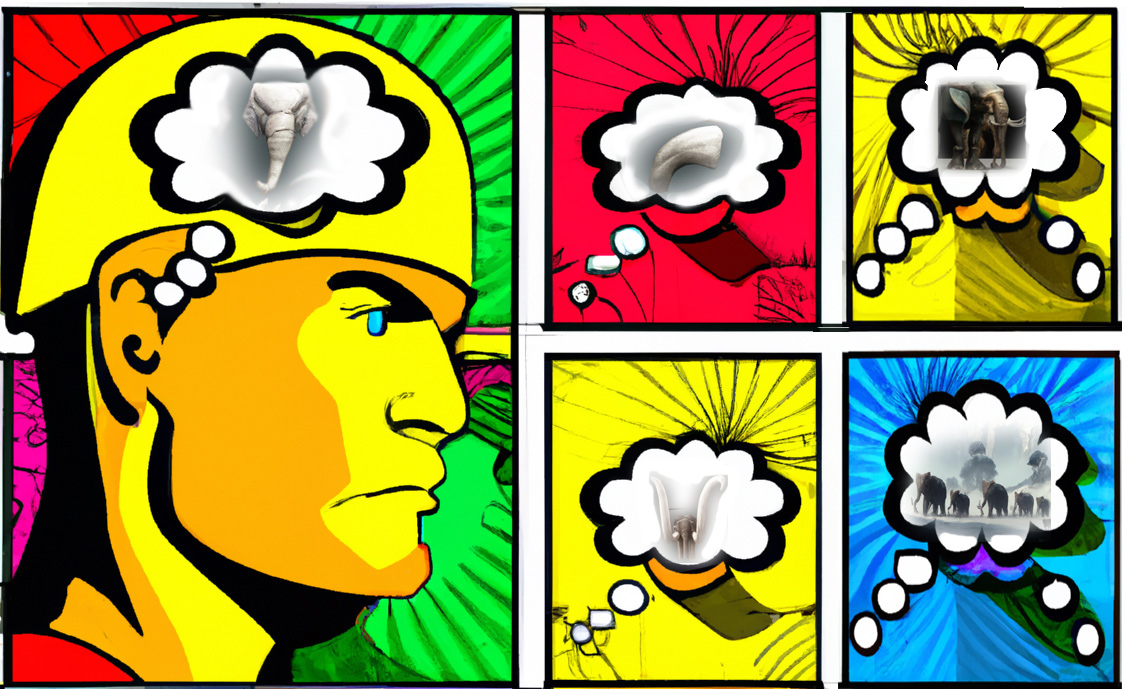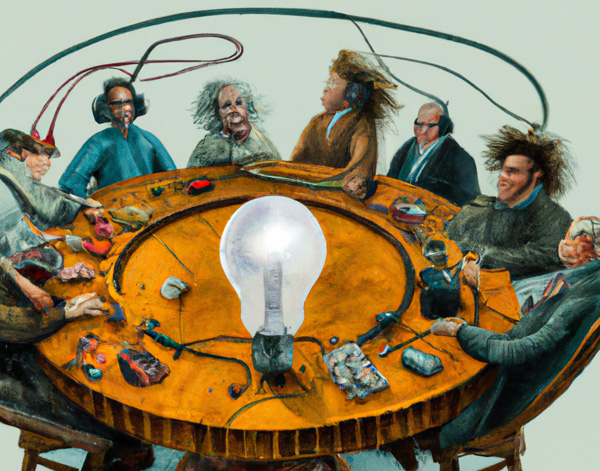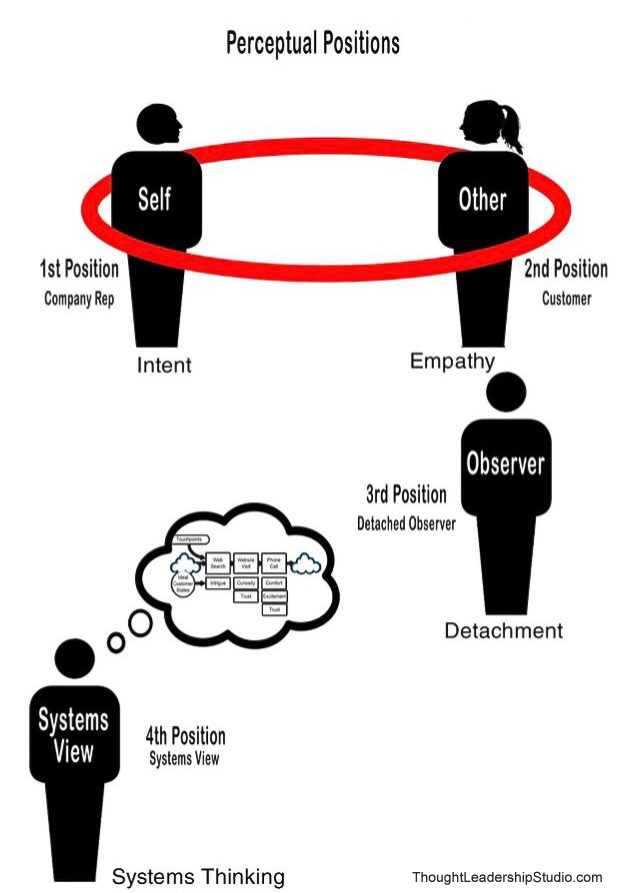Thought Leadership Studio Podcast Episodes:
The Magic of Multiple Perspectives
Episode 34 - Mental Skills for Thought Leadership and Market Leadership - How Taking Multiple Perspectives Opens Up Creative Possibilities and Enables High-Impact Positive Influence

#ai, #artificialintelligence, #coaching, #creativity, #customerexperience, #experiencemarketing, #imagination, #insight, #inspiration, #leadership, #marketingresearch, #marketingstrategy, #marketresearch, #mentaltraining, #neurolinguisticprogramming, #paradigmchange, #systemsthinking, #thoughtexperiments, #thoughtleadership, #workshop
Or Click here to listen or subscribe on appWhat this episode will do for you
- Discover 4 learnable thinking strategies of creative geniuses.
- Get acquainted with the triple perspective Imagineering strategy of Walt Disney that enabled him to combine creativity with business success.
- Contrast buyer personas with a more powerful way to gain and utilize the insights from taking the customer and prospect perspective.
- Learn how to more consciously switch perspectives to gain new insights on an issue.
- Learn the 4 Chairs exercise for expanding your thinking and gaining customer empathy.

Are you tired of your company's online presence falling short of your expectations? Look no further than 5th Level Web - the web development and internet marketing company that makes the internet turn-key for companies with $5-$100M in annual sales.
5th Level Web is for market leaders. We make sure your web presence reinforces and supports your leadership.
At 5th Level Web, we have high-level tech experts on hand to ensure quick response times and top-notch service. Our team will work with you to create a compelling message and web presence that sets you apart from the competition, establishing your company as a market leader with the THAUT process of strategic thought leadership.
Click Here to schedule your free offer as a listener/reader of Thought Leadership Studio: a Free Web Analysis and Consultation.Curated Transcript of Podcast Episode 34- The Magic of Multiple Perspectives.
The transcript is lightly edited for clarity and is a partial transcript (with some bonus content)- the full episode is on audio. Click here to listen.
Self-Mastery in the Age of AI
In this age of AI (Artificial Intelligence) we need to remember that - technology will not replace creative human thinking, so
- Self-mastery in service of innovative thinking and expression is still the path
For some perspective, consider how Noam Chomsky called ChatGPT, "auto-complete on steroids".
But things are changing and we need to account for that. Maybe it's an opportunity as many of your competitors are rushing to AI and perhaps over-using it in places where it leads to group-think and repetition, creating an opening for you to stand out even more with creative thought leadership positions that could be informed from some angles by AI, but that could not have come solely from AI ... because they didn't exist before.
Especially now that anyone can generate content with AI, human creativity is essential to creating content that will stand out which can come from what I call Strategic Thought Leadership. AI has its place on the research side but standing out and cutting through the clutter requires taking an authoritative, unique position and articulating it in a powerful way that AI alone could not have done.
Otherwise, your prospects could have simply asked ChatGPT.
Creativity as Differentiator
 One measure of creativity is how different your behavior is than what AI could have predicted based on your past history.
One measure of creativity is how different your behavior is than what AI could have predicted based on your past history.
If we accept that creativity gives the confidence of strategic advantage in the age of AI, then the question becomes, how to get more creative? Or, operating from the paradigm that creativity is innate, how can we open ourselves up to better and more fully express our innate creativity?
A good point to remember is that creativity comes from the unconscious mind... "out of the blue", so to speak; but we can always get more effective at consciously inviting creativity. One way to get better at consciously inviting creative, or inspired states, is to study and model the thinking strategies that are common in creative geniuses and are uncommon in others.
Since these characteristics are learnable, we have a path towards developing our own creative genius, developing visions of positive breakthroughs, and bringing them to life.
Here are some:
Four Strategies for Creativity
- Multiple Perspectives - See things from different angles to access different information.
- Using both conscious and unconscious processes - Know when to "let" things come to you and when to intentionally think deeply on something.
- Accessing and applying powerful, positive states - Create an expectation of success and hold it.
- Create and access a detailed sensory world, - Have a vivid and well-controlled imagination that you harness as a tool for success.
The focus of this podcast is on the first of these four strategies: Multiple Perspectives.
Multiple Perspective Thinking
 Pivoting between perspectives is a key mental skill. Switching positions gathers new information and adds another frame within which to consider things.
Pivoting between perspectives is a key mental skill. Switching positions gathers new information and adds another frame within which to consider things.
John Grinder, one of the co-founders of NLP (Neuro-Linguistic Programming), emphasizes the importance of taking multiple perspectives when communicating and understanding others. He believes that to effectively communicate, one needs to understand the other person's perspective and be able to adopt their frame of reference. This means being able to see the situation from their point of view and understanding their thoughts, feelings, and beliefs. By doing so, one can build rapport and connect with the other person on a deeper level.
Grinder also advocates for being aware of one's own perspective and being able to shift it as needed. This allows for greater flexibility and adaptability in communication and can help to avoid misunderstandings and conflicts.
A strategy of multiple perspectives can also support innovation.
Walt Disney's "Imagineering": the Dreamer, the Realist, and the Critic
 Walt Disney was known for his ability to shift between multiple perspectives and think creatively in order to bring his ideas to life. Have you ever encountered the paradigm that creative people aren't businesslike and businesspeople aren't creative? Disney proved that wrong by harnessing creativity aligned with business success.
Walt Disney was known for his ability to shift between multiple perspectives and think creatively in order to bring his ideas to life. Have you ever encountered the paradigm that creative people aren't businesslike and businesspeople aren't creative? Disney proved that wrong by harnessing creativity aligned with business success.
In Strategies of Genius, Volume I, Robert Dilts modeled the Disney Strategy which had 3 perspectives: the Dreamer, the Realist, and the Critic.
Each of these three perspectives had unique advantages and characteristics. Part of Disney's innovation was separating them into distinct rooms so they didn't cross-contaminate and hinder each's full expression.
Let's consider each in turn.
The Dreamer
The Dreamer state is visual and future-facing. Disney would imagine far-off possibilities, with no limitations. In this room, he would see an expansive vision of the future.
The Realist
Once the Dreamer developed a full vision, he would go to the next room of The Realist. This state is kinesthetic and action-oriented. It is focused on what can be accomplished here and now. The Realist state is about chunking down the dreams of The Dreamer in step-by-step goals so that the first step has a realistic probability of success.
The Critic
Once the Realist has broken the visions of the Dreamer into bite-size actionable steps, this plan is brought to the room of The Critic. This strategy is auditory in the sense that the role of the critic is to go through a mental checklist of criteria to contrast the plan from the Dreamer and the Realist with an ideal. Of course, the idea is to criticize the plan, not the planner, and do it in service of making it the best plan possible. From this position, a set of necessary improvements might be generated which could be taken back to the room of the Dreamer to come up with solutions for each.
Of course, Disney's Imagineering is just one example of a multiple-perspective strategy that can lead to extraordinary results.
A Hypothetical Workshop in Multiple Perspectives: The Sports Fan Example
If I was giving a workshop on multiple perspective thinking to a marketing or sales team, I might help them warm up with a few examples at least some of them could relate to.
 Imagine we are in a conference room. The sunlight throws shafts of gold from the tall windows onto the round table of suited businesspeople. The hum and cold blast of the AC plays counterpoint to questions intoned with curiosity. The older projector adds a fog of the smell of a burning hot bulb.
Imagine we are in a conference room. The sunlight throws shafts of gold from the tall windows onto the round table of suited businesspeople. The hum and cold blast of the AC plays counterpoint to questions intoned with curiosity. The older projector adds a fog of the smell of a burning hot bulb.
For sports fans, I might ask them to imagine being at a close game between their team and a rival. The crowd is screaming as new scores flash on the boards.
Shift channels: They then get a job as a referee whose role is to see both sides equally and impartially with fair and just penalty calls. When you see the opposing team as an impartial referee, how do you see them differently?
Shift channels again: Then imagine you get a job as a coach for the opposing team and are paid very well to help them succeed. How does that shift how you see your team? The opposing team?
Shift channels yet again: Now you are a coach for your team, again immersed in a role of not only rooting for them to win but being partially responsible for it. Can you see how being able to pivot temporarily to those other roles and bring these different things you notice from these other perspectives could actually serve you in creating a better winning strategy for your team?
Can you see the value of being able to temporarily suspend your normal mindset in service of expanding your thinking with new perspectives adds insights you won't get by only immersing more deeply into whatever your normal point of view is?
It's the power of pivoting points of view.
This is also helpful in negotiation. If you want to change someone's mind, you could simply make a case for your different point of view by undermining their point of view in favor of yours and listing the advantages of your point of view. How do you think people respond to being told they are wrong, though?
What if, instead, you pivoted to their point of view and validated it first, saying something like "From your angle, I completely agree. You are right .... from that point of view. What if we shifted to this other point of view, though, and examine the issue from there?
Do you see how that could be more influential?
Beyond Buyer Personas
 Buyer personas are a way to start to gain empathy for the customer point of view.
Buyer personas are a way to start to gain empathy for the customer point of view.
A buyer persona is a fictional representation of an ideal customer based on market research and data about your target audience. The reason for creating this character is to bring the customers perspective more fully to life with sensory information and a history. The idea is that knowing a target customer's demographic, psychographic, and behavioral characteristics will help you to better understand their needs, preferences, motivations, and goals.
This is moving in the right direction but is it really enough? Would creating a fictional representation of a referee really give you their perspective or is it actually pivoting to see things from their eyes, hear from their ears, and feel what they feel with a sense of immersion in their reality that grants new information that makes a difference?
Until we learn to see our businesses and services through the filtered lens of our clients' and prospects' more limited understand of what we do - what I call wearing a limitation mask - there is a disconnect that can prevent fully harvesting the breakthrough growth our businesses are capable of. When we understand the customer sets the value of a service and design our marketing and services from the outside in, we have the maximum positive impact and results.
There are thought experiments, some derived from Systems Thinking or Neuro-Linguistics, that go much further in developing and gathering new, insightful information from multiple perspectives.
One of those is what I call the "4 Chairs Exercise". It is derived in part from a method called Cleaning Perceptual Positions.
It also references what we call "Double Loop Learning" from Systems Thinking, which is learning on the level of challenging the assumptions behind a skill and being open to changing those assumptions rather than simply learning to improve a skill based on a certain assumption.
Double loop learning seeds breakthroughs in business results like sales and customer service.
Now, for the exercise:
Four Chairs Perceptual Positions Exercise

- Set up 4 chairs, 2 facing each other (1st and 2nd positions), a 3rd chair a bit back looking at the center point of the first 2 (3rd = detached observer) and a 4th yet farther back and pointed to the midpoint of the other 3 (4th = systems view)
- Sit in 1st position while imagining you are selling and serving a customer in person or writing to prospects to sell and serve them through media.
- Step out, stand up, and walk around to "shake off" that state of mind. Think of a time when you were the prospective customer of a company whose products or services you know about as well as your typical customer knows yours. Choose a company that sells something you are interested in but whose offering is in a category you could stand to learn more about to make a good decision. Also, pick something that you are interested in but not ready to buy. As you see what you would see, hear what you would hear, and feel how you would feel either engaging in person or through media, sit in the 2nd position chair and imagine a rep of that company is in the chair for #1... either interacting with you in person or remotely creating the content you are reading, likely with the help of a thought leadership marketer. In your imagination, immerse in this fully.
- Again, step out, stand up, and walk around to "shake off" that state of mind. Remember a time when you watched an interaction between 2 people as a detached observer. You were interested in what was going on and observant but not taking one side or another. As you remember this, sit in the 3rd position chair. As you sit there, fully immerse back in that time, seeing, hearing, and feeling everything you can remember as if it's happening again.
- Yet again, stand up and shake off the state. This time, remember a time when you had to understand a process from a diagram. It could be installing a printer from a quick start pictorial manual, for instance. As you think about this, sit in the 4th position chair and fully immerse in it, again, seeing, hearing, and feeling it like you are fully back in the experience.
Questions to ask when in each position
- 1st position - the actor
- What is my intent?
- How do I perceive 2nd position?
- What else affects me?
- What am I feeling?
- 2nd position - the acted upon
- What is my intent?
- How do I perceive 1st position?
- What else affects me?
- What am I feeling?
- 3rd position - the impartial observer
- What is the intent of 1st position?
- What is the intent of 2nd position?
- How do I perceive 1st position?
- How do I perceive 2nd position?
- What else affects them both?
- How is each thinking?
- 4th position - the systems thinker
- What is the purpose of the interaction between 1st & 2nd position as a system?
- What are the inputs and outputs from the system?
- What dynamics drive the system towards its purpose or equilibrium?
(Advanced) Cleaning Perceptual Positions
- 1st position - the actor
- In your mind's eye, where do you see the person in 2nd position? Are you looking up or down at them? If either, adjust so that you see them "eye-to-eye", level with you.
- As you think about the conversation, do you hear their voice coming from them (the person in 2nd position) or from somewhere else? If somewhere else, move it to where you see them.
- 2nd position - the acted upon
- Where do you see the person in 1st position as you see them in your mind's eye? Are you looking up or down at them? If either, adjust so that you see them "eye-to-eye", level with you.
- Do you hear the person in 1st position's voice coming from them or from somewhere else as you see them in your mind's ear? If somewhere else, move it to where you see them.
- 3rd position - the impartial observer
- Are 1st and 2nd position the same height and distance from you? If not, adjust so they are.
- As you see them in your mind's eye, do you see 1st and 2nd position with the same level of detail, contrast, and color? If not, adjust so you do.
- As you hear them in your mind's ear, do you hear each of their voices coming from them or somewhere else? If somewhere else, move the voice to where it belongs.
- In your thoughts, do you notice 1st and 2nd positions feelings coming from them or somewhere else? If somewhere else, move the feelings into the person they belong in.
- After making all adjustments to "level up" the interaction in your imagination, move back to 1st and 2nd position and notice the differences from each.
- 4th position - the systems thinker
- Write down the system purpose of the interaction.
- Use a tool like Loopy to create a causal looping diagram to study the dynamics as a system.
The transcript is lightly edited for clarity and is a partial transcript (with some bonus content)- the full episode is on audio. Click here to listen.
***************************************
Free Stuff and Offers Mentioned in Podcast
***************************************
***************************************